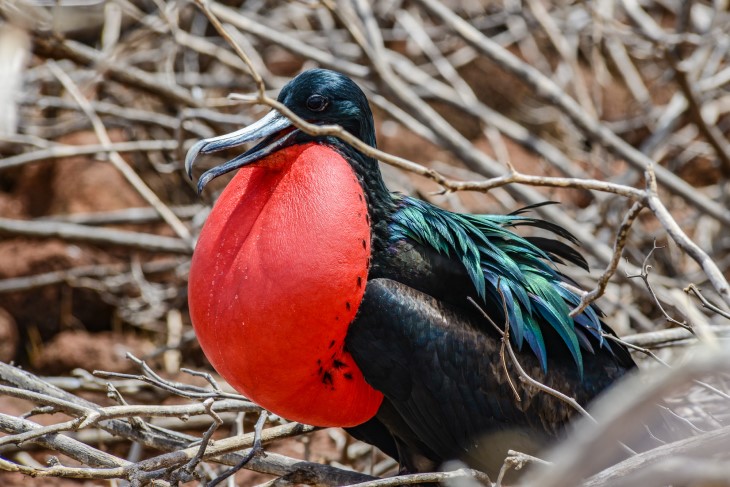
SIGN UP TO RECEIVE
15% OFF
IN YOUR NEXT TOUR

Exploring the World of Frigatebirds: How Many Species Are There?
SCROLL DOWN TO READ

Exploring the World of Frigatebirds: How Many Species Are There?
SCROLL DOWN TO READ
Exploring the World of Frigatebirds: How Many Species Are There?
Frigatebirds are a captivating family of five closely related species, all classified under the single genus Fregata. These remarkable seabirds are masterfully adapted for life in the skies, boasting a streamlined body and long, slender wings that can stretch up to an impressive 2.3 meters (nearly 8 feet). With their deeply forked tails, small rounded heads, short necks, and elongated bills, they embody the essence of aerial grace. Frigatebirds thrive in coastal and pelagic waters, soaring effortlessly through the warm seas and oceans of the tropics and subtropics, where food resources—especially flying fish—are abundant, and the wind conditions are perfect for their soaring and gliding behavior.
While they may look quite similar at a glance, each species possesses unique physical traits that make them easier to identify up close. Remarkably, frigatebirds can spend several days and nights aloft, yet they become quite clumsy on land. Taking off from solid ground is a challenge, and launching into the air from the water is nearly impossible. They typically nest in trees, providing a safe perch for takeoff, though they can also be found nesting on the ground. Interestingly, frigatebirds don’t swim or dive; instead, they catch their meals by skimming low over the water's surface and snagging fish with their bills. Lacking waterproof plumage, these aerial specialists must rely on their impressive flight skills to hunt above the waves.
Ascension frigatebird (Fregata aquila)
Meet the Ascension frigatebird, a fascinating seabird that, despite its smaller size, shares striking similarities with the magnificent frigatebird. Adult males flaunt their resemblance, while the females present a captivating palette of brownish-black feathers accented with a rusty brown mantle and chest. Unlike their counterparts, female Ascension frigatebirds typically lack the white patches that are common in other species. Occasionally, you might spot a female with a white belly—an indication that she’s breeding before fully maturing into her adult plumage.
What sets the Ascension frigatebird apart is its unique nesting behavior. These birds nest exclusively on the ground, not by choice but rather out of necessity, given their habitat. They are primarily found on Boatswain Bird Island, just off the coast of Ascension Island in the tropical Atlantic Ocean. Remarkably, they haven’t bred on the main island since the 1800s, making their current nesting grounds all the more special. Unfortunately, this species is classified as Vulnerable, highlighting the need for conservation efforts to protect their delicate habitat.
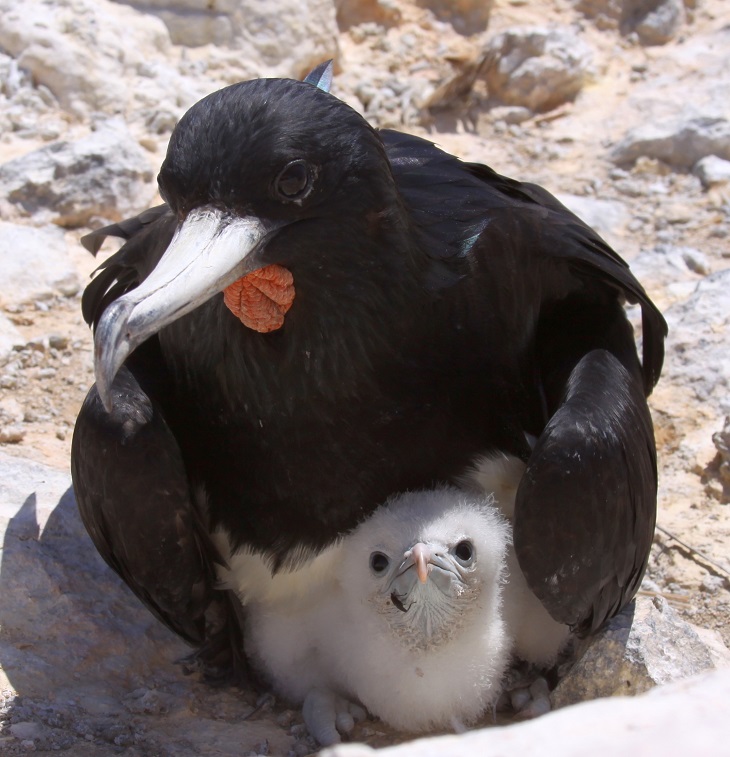
Magnificent frigatebird (Fregata magnificens)
With a body length of 89–114 cm (35–45 in), it is the largest species and has the longest bill. The adult male is entirely black, with a scarlet throat pouch that inflates like a balloon during the breeding season. Although the feathers are black, the scapular feathers have a purple sheen, in contrast to the male great frigatebird’s green sheen. The female is brownish-black but has a white breast and lower neck sides, a brown band on the wings, and a bluish-grey eye-ring. Widespread in the tropical Atlantic, it breeds in colonies in trees in Florida, the Caribbean, and the Cape Verde Islands, as well as along the Pacific coast of the Americas from Mexico to Ecuador, including the Galápagos Islands.
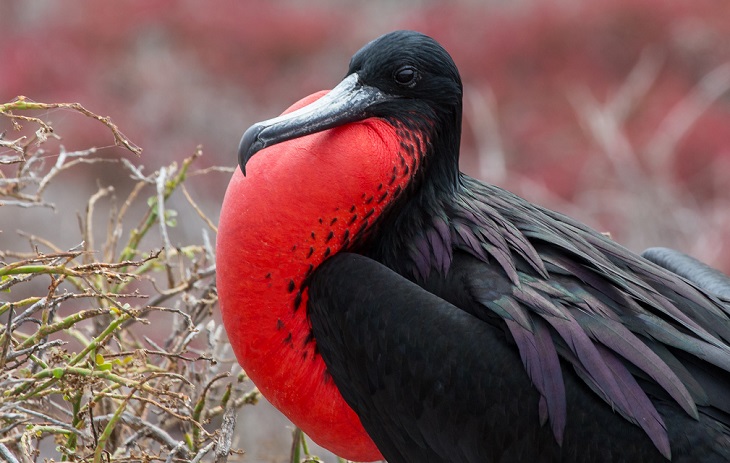

Lesser frigatebird (Fregata ariel)
With a body length of around 75 cm (30 in), this is the smallest species. The adult male has black upperparts with a greenish to purple metallic gloss on the mantle and scapulars and is black underneath except for bold white axillary spurs. The female’s upperparts are dark with lighter wing bars. Its head is black, while the belly and neck collar are white. Except for the Lesser Frigatebird, which has a wingspan of 193 centimeters, the other four species have wingspans exceeding two meters, reaching up to 244 centimeters in the Great Frigatebird. This species is found in tropical and subtropical waters across the Indian and Pacific Oceans. The Atlantic subspecies trinitatis was once restricted to Trindade Island, off eastern Brazil, but it may now be extinct.

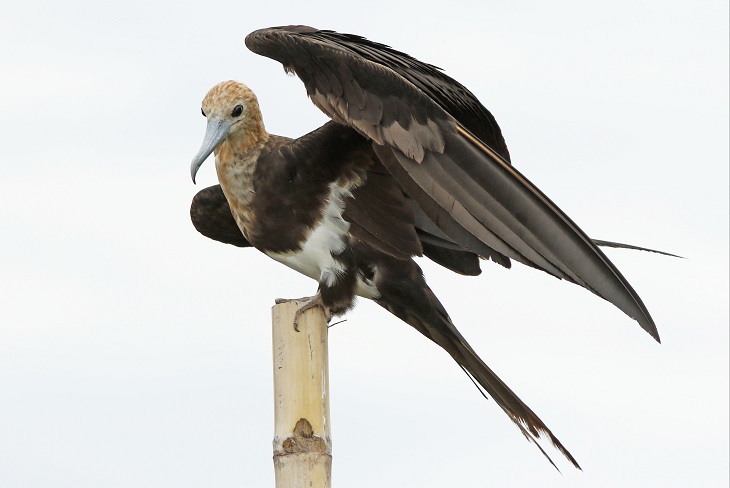
Christmas frigatebird (Fregata andrewsi)
The adult male of this frigatebird species is unique among its kind, distinguished by an egg-shaped white patch on its belly. It is also larger, with a longer bill compared to the closely related great frigatebird. Its upperparts are black with a striking green metallic gloss on the mantle and scapulars. The female has dark upperparts highlighted by brown wing bars, a black head, and a white belly, along with a sometimes-incomplete white collar around her neck. This species breeds exclusively on Christmas Island in the Indian Ocean and forages in the nearby waters. Unfortunately, it is considered critically endangered, with its population currently in decline.
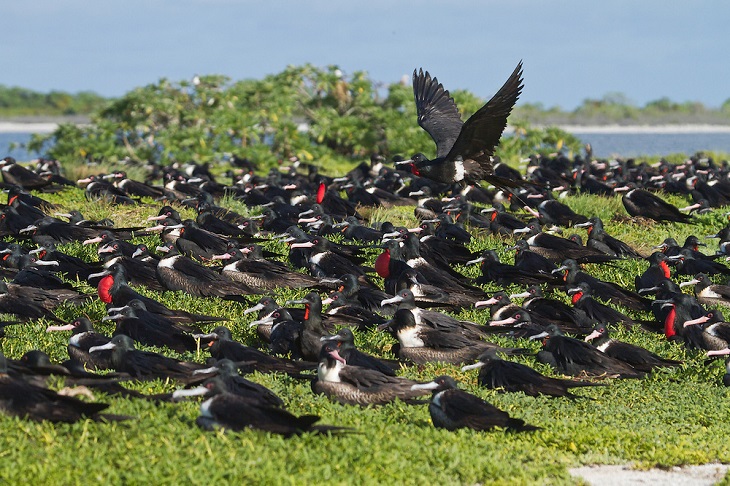

Great frigatebird (Fregata minor)
The Great Frigatebird (Fregata minor) is one of the most widely distributed frigatebird species, inhabiting tropical and subtropical waters in the Pacific and Indian Oceans, as well as having colonies on the Galapagos Islands and the Trindade and Martim Vaz islands in the South Atlantic. It can be distinguished by its size and striking plumage. The adult male is entirely black, with a greenish metallic sheen on the mantle and scapulars, and subtle brown barring under the wings, while the female has dark upperparts, lighter brown wing bars, a black head, and a white collar around the neck, along with a mottled throat and belly. In comparison to other frigatebird species—like the Lesser Frigatebird, which is smaller and has more subtle color contrasts—the Great Frigatebird is larger with a longer bill and more prominent, iridescent plumage. Unlike the Magnificent Frigatebird, whose males exhibit a more extensive purplish gloss, the Great Frigatebird has a greenish tint. The Great Frigatebird’s red throat pouch, which males inflate to attract females, is a common trait among frigatebirds but stands out for its size and vividness during courtship displays. Overall, the Great Frigatebird’s widespread range and distinctive coloration make it a fascinating species within the frigatebird family.

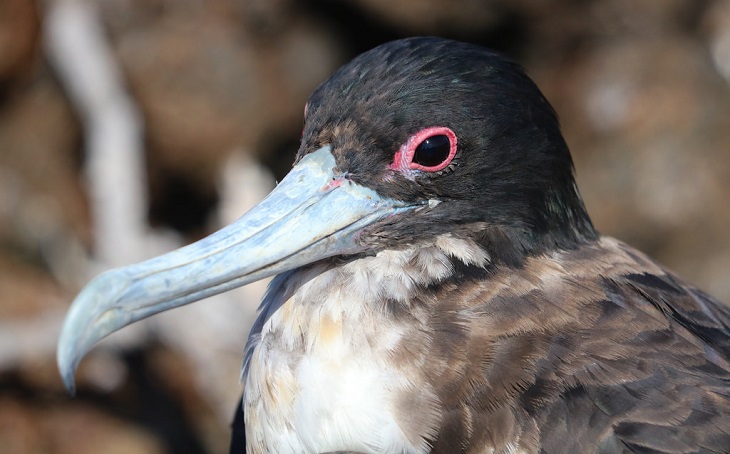
In frigatebirds, sexual dimorphism is pronounced. The bright red gular pouch of males becomes especially conspicuous during courtship displays when fully inflated, while females have generally duller plumage with often prominent white areas on the underparts. Juveniles typically have buff to apricot-colored heads and necks, with a browner overall plumage. Adult males display black plumage with iridescent blue, purple, and green gloss on the head, neck, and mantle, along with varying degrees of white markings on the underparts—ranging from a white belly in the Christmas Frigatebird to small white crescents on the axillaries in the Lesser Frigatebird. Outside the breeding season, the red gular pouch is greatly reduced. Males also have a long, hooked bill in dark gray to blackish tones, dark brown eyes with a dark eye-ring, and blackish legs and partially webbed feet.
Females, on the other hand, have blackish-brown plumage on the head and upperparts with less gloss, but their underparts often show a significant white patch from the lower breast to the lower belly. However, the dark morph female of the Ascension Frigatebird resembles the male closely, differing mainly by a brown pectoral band (present in both dark and pale morphs). Females have pale bluish-gray to pale pink bills, dark eyes with a pinkish-red eye-ring (purplish-blue in the Magnificent Frigatebird), and mostly pinkish legs and feet.
